BA Business Decision Making Report: Investment Appraisal of A&B Plc
VerifiedAdded on 2023/01/07
|8
|1572
|86
Report
AI Summary
This report delves into the critical aspects of business decision-making, focusing on investment appraisal techniques. It provides a numerical analysis of A&B Plc, illustrating the application of Net Present Value (NPV) and payback period methods to evaluate investment projects. The report calculates and interprets payback periods and NPVs for two projects (Dishwashing and Software), comparing their financial viability. It also examines both financial factors (e.g., gross profit, working capital) and non-financial factors (e.g., market competition, industry growth) that influence business decisions. Furthermore, the report analyzes the advantages and disadvantages of both NPV and payback period methods, providing a comprehensive understanding of their roles in strategic decision-making. The conclusion emphasizes the importance of investment appraisal in making informed business choices, highlighting the need for managers to utilize various strategies for quick evaluations and strategic advantages.

Business
Decision-Making
Decision-Making
Paraphrase This Document
Need a fresh take? Get an instant paraphrase of this document with our AI Paraphraser
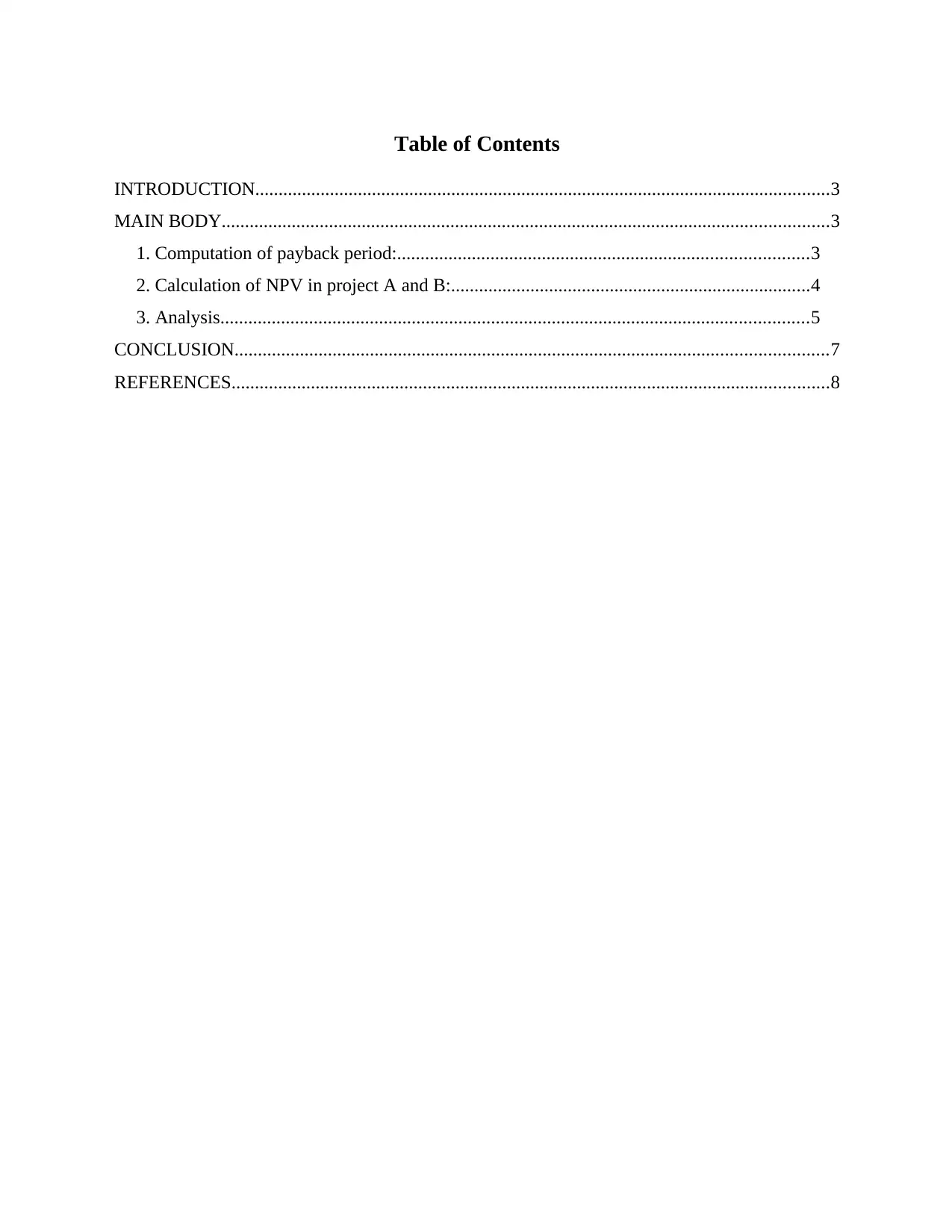
Table of Contents
INTRODUCTION...........................................................................................................................3
MAIN BODY..................................................................................................................................3
1. Computation of payback period:........................................................................................3
2. Calculation of NPV in project A and B:.............................................................................4
3. Analysis..............................................................................................................................5
CONCLUSION...............................................................................................................................7
REFERENCES................................................................................................................................8
INTRODUCTION...........................................................................................................................3
MAIN BODY..................................................................................................................................3
1. Computation of payback period:........................................................................................3
2. Calculation of NPV in project A and B:.............................................................................4
3. Analysis..............................................................................................................................5
CONCLUSION...............................................................................................................................7
REFERENCES................................................................................................................................8
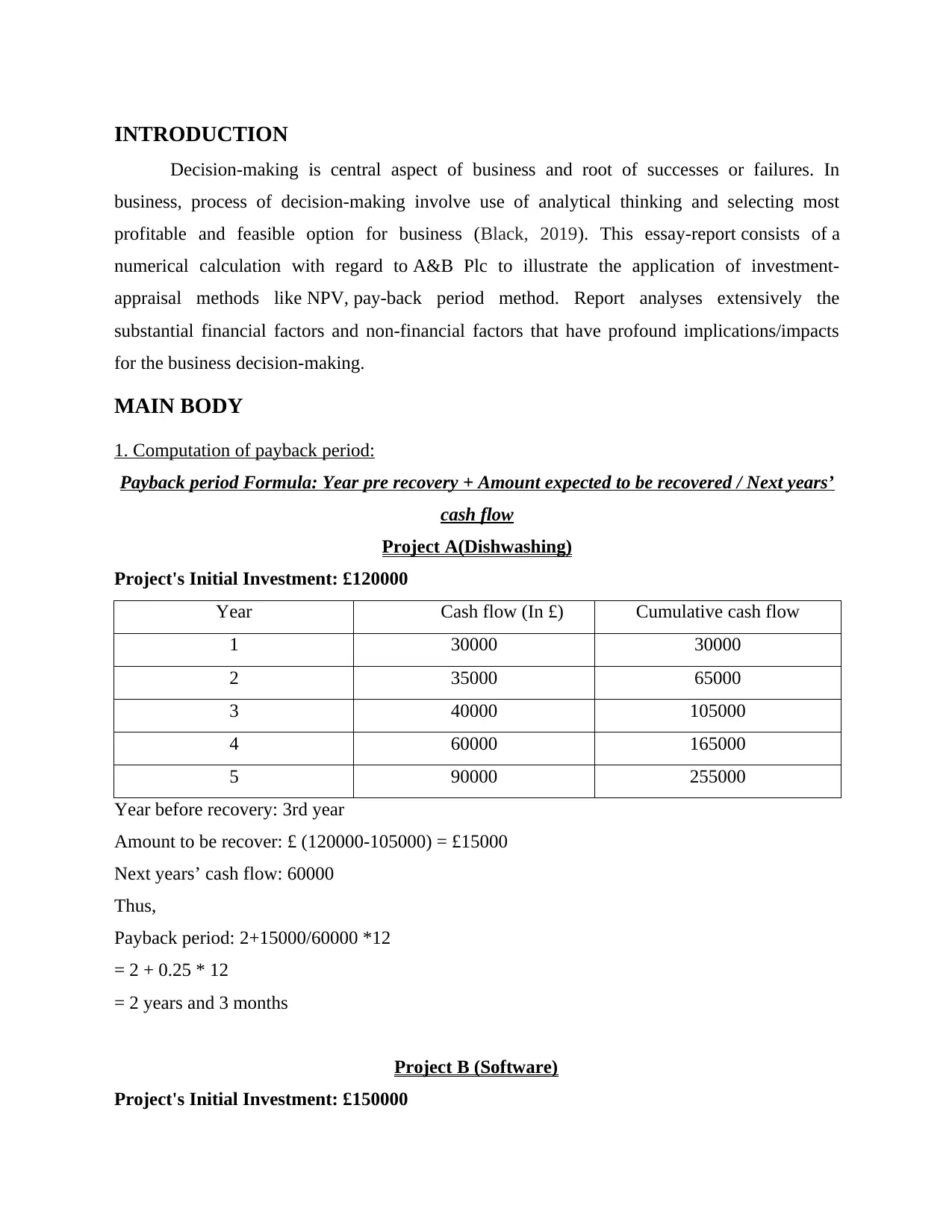
INTRODUCTION
Decision-making is central aspect of business and root of successes or failures. In
business, process of decision-making involve use of analytical thinking and selecting most
profitable and feasible option for business (Black, 2019). This essay-report consists of a
numerical calculation with regard to A&B Plc to illustrate the application of investment-
appraisal methods like NPV, pay-back period method. Report analyses extensively the
substantial financial factors and non-financial factors that have profound implications/impacts
for the business decision-making.
MAIN BODY
1. Computation of payback period:
Payback period Formula: Year pre recovery + Amount expected to be recovered / Next years’
cash flow
Project A(Dishwashing)
Project's Initial Investment: £120000
Year Cash flow (In £) Cumulative cash flow
1 30000 30000
2 35000 65000
3 40000 105000
4 60000 165000
5 90000 255000
Year before recovery: 3rd year
Amount to be recover: £ (120000-105000) = £15000
Next years’ cash flow: 60000
Thus,
Payback period: 2+15000/60000 *12
= 2 + 0.25 * 12
= 2 years and 3 months
Project B (Software)
Project's Initial Investment: £150000
Decision-making is central aspect of business and root of successes or failures. In
business, process of decision-making involve use of analytical thinking and selecting most
profitable and feasible option for business (Black, 2019). This essay-report consists of a
numerical calculation with regard to A&B Plc to illustrate the application of investment-
appraisal methods like NPV, pay-back period method. Report analyses extensively the
substantial financial factors and non-financial factors that have profound implications/impacts
for the business decision-making.
MAIN BODY
1. Computation of payback period:
Payback period Formula: Year pre recovery + Amount expected to be recovered / Next years’
cash flow
Project A(Dishwashing)
Project's Initial Investment: £120000
Year Cash flow (In £) Cumulative cash flow
1 30000 30000
2 35000 65000
3 40000 105000
4 60000 165000
5 90000 255000
Year before recovery: 3rd year
Amount to be recover: £ (120000-105000) = £15000
Next years’ cash flow: 60000
Thus,
Payback period: 2+15000/60000 *12
= 2 + 0.25 * 12
= 2 years and 3 months
Project B (Software)
Project's Initial Investment: £150000
⊘ This is a preview!⊘
Do you want full access?
Subscribe today to unlock all pages.

Trusted by 1+ million students worldwide
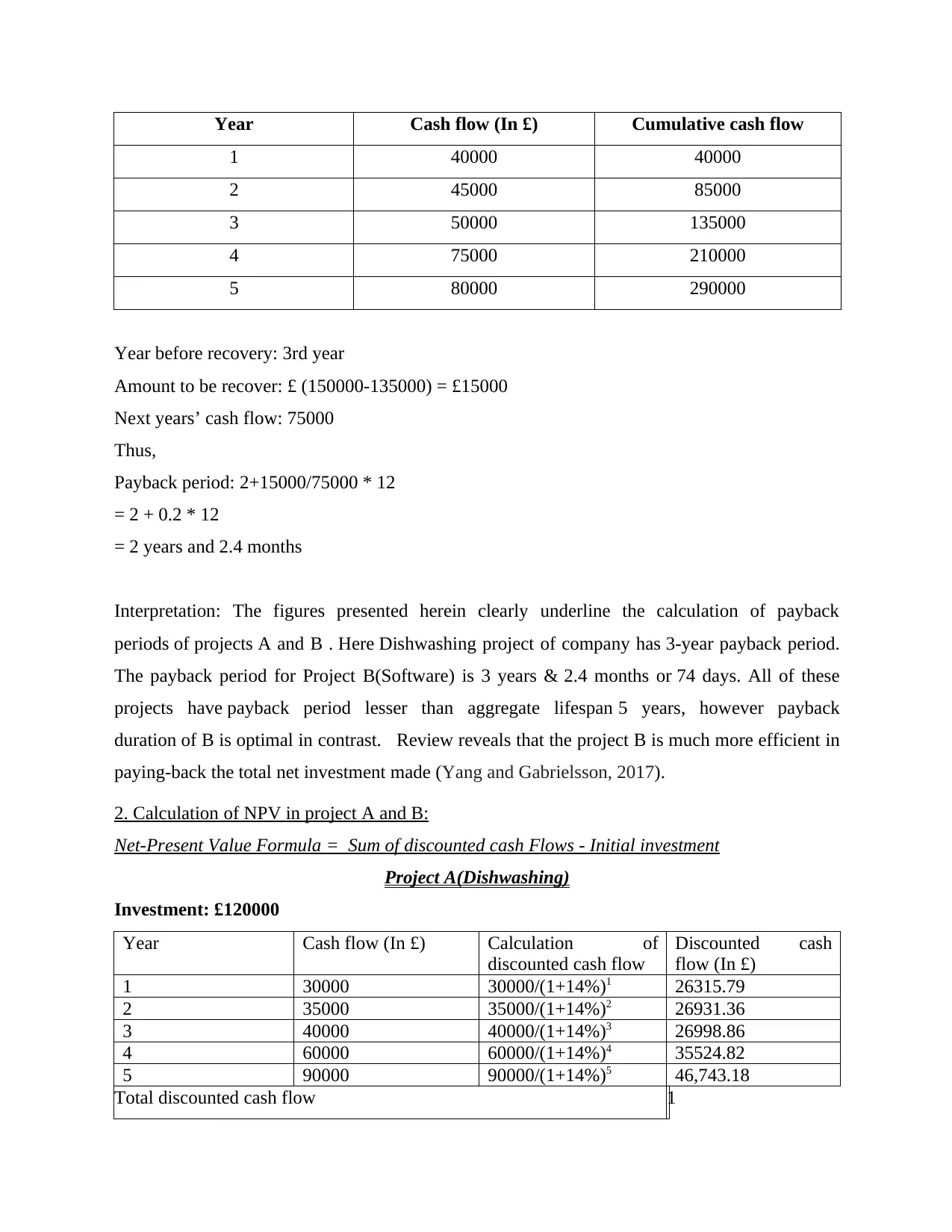
Year Cash flow (In £) Cumulative cash flow
1 40000 40000
2 45000 85000
3 50000 135000
4 75000 210000
5 80000 290000
Year before recovery: 3rd year
Amount to be recover: £ (150000-135000) = £15000
Next years’ cash flow: 75000
Thus,
Payback period: 2+15000/75000 * 12
= 2 + 0.2 * 12
= 2 years and 2.4 months
Interpretation: The figures presented herein clearly underline the calculation of payback
periods of projects A and B . Here Dishwashing project of company has 3-year payback period.
The payback period for Project B(Software) is 3 years & 2.4 months or 74 days. All of these
projects have payback period lesser than aggregate lifespan 5 years, however payback
duration of B is optimal in contrast. Review reveals that the project B is much more efficient in
paying-back the total net investment made (Yang and Gabrielsson, 2017).
2. Calculation of NPV in project A and B:
Net-Present Value Formula = Sum of discounted cash Flows - Initial investment
Project A(Dishwashing)
Investment: £120000
Year Cash flow (In £) Calculation of
discounted cash flow
Discounted cash
flow (In £)
1 30000 30000/(1+14%)1 26315.79
2 35000 35000/(1+14%)2 26931.36
3 40000 40000/(1+14%)3 26998.86
4 60000 60000/(1+14%)4 35524.82
5 90000 90000/(1+14%)5 46,743.18
Total discounted cash flow 1
1 40000 40000
2 45000 85000
3 50000 135000
4 75000 210000
5 80000 290000
Year before recovery: 3rd year
Amount to be recover: £ (150000-135000) = £15000
Next years’ cash flow: 75000
Thus,
Payback period: 2+15000/75000 * 12
= 2 + 0.2 * 12
= 2 years and 2.4 months
Interpretation: The figures presented herein clearly underline the calculation of payback
periods of projects A and B . Here Dishwashing project of company has 3-year payback period.
The payback period for Project B(Software) is 3 years & 2.4 months or 74 days. All of these
projects have payback period lesser than aggregate lifespan 5 years, however payback
duration of B is optimal in contrast. Review reveals that the project B is much more efficient in
paying-back the total net investment made (Yang and Gabrielsson, 2017).
2. Calculation of NPV in project A and B:
Net-Present Value Formula = Sum of discounted cash Flows - Initial investment
Project A(Dishwashing)
Investment: £120000
Year Cash flow (In £) Calculation of
discounted cash flow
Discounted cash
flow (In £)
1 30000 30000/(1+14%)1 26315.79
2 35000 35000/(1+14%)2 26931.36
3 40000 40000/(1+14%)3 26998.86
4 60000 60000/(1+14%)4 35524.82
5 90000 90000/(1+14%)5 46,743.18
Total discounted cash flow 1
Paraphrase This Document
Need a fresh take? Get an instant paraphrase of this document with our AI Paraphraser
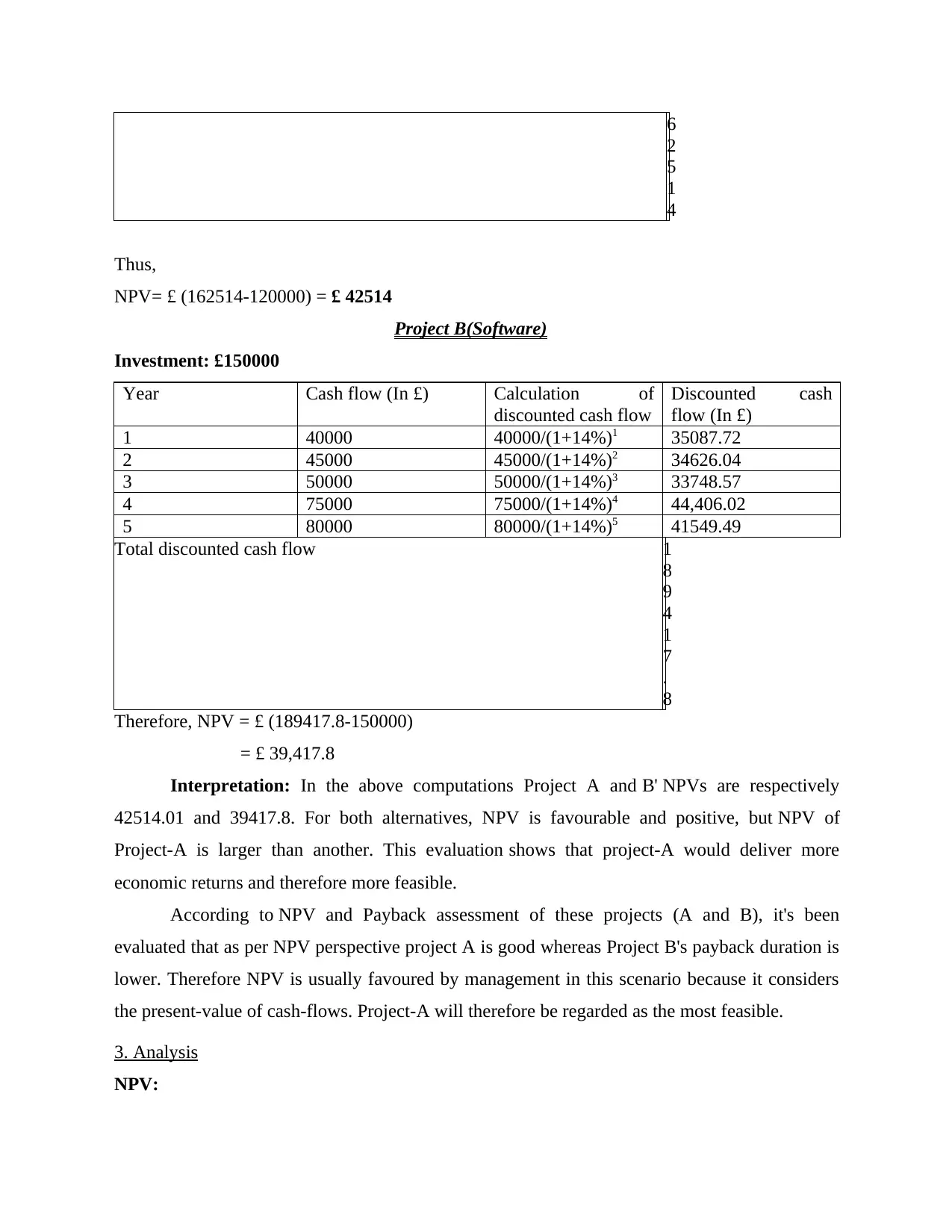
6
2
5
1
4
Thus,
NPV= £ (162514-120000) = £ 42514
Project B(Software)
Investment: £150000
Year Cash flow (In £) Calculation of
discounted cash flow
Discounted cash
flow (In £)
1 40000 40000/(1+14%)1 35087.72
2 45000 45000/(1+14%)2 34626.04
3 50000 50000/(1+14%)3 33748.57
4 75000 75000/(1+14%)4 44,406.02
5 80000 80000/(1+14%)5 41549.49
Total discounted cash flow 1
8
9
4
1
7
.
8
Therefore, NPV = £ (189417.8-150000)
= £ 39,417.8
Interpretation: In the above computations Project A and B' NPVs are respectively
42514.01 and 39417.8. For both alternatives, NPV is favourable and positive, but NPV of
Project-A is larger than another. This evaluation shows that project-A would deliver more
economic returns and therefore more feasible.
According to NPV and Payback assessment of these projects (A and B), it's been
evaluated that as per NPV perspective project A is good whereas Project B's payback duration is
lower. Therefore NPV is usually favoured by management in this scenario because it considers
the present-value of cash-flows. Project-A will therefore be regarded as the most feasible.
3. Analysis
NPV:
2
5
1
4
Thus,
NPV= £ (162514-120000) = £ 42514
Project B(Software)
Investment: £150000
Year Cash flow (In £) Calculation of
discounted cash flow
Discounted cash
flow (In £)
1 40000 40000/(1+14%)1 35087.72
2 45000 45000/(1+14%)2 34626.04
3 50000 50000/(1+14%)3 33748.57
4 75000 75000/(1+14%)4 44,406.02
5 80000 80000/(1+14%)5 41549.49
Total discounted cash flow 1
8
9
4
1
7
.
8
Therefore, NPV = £ (189417.8-150000)
= £ 39,417.8
Interpretation: In the above computations Project A and B' NPVs are respectively
42514.01 and 39417.8. For both alternatives, NPV is favourable and positive, but NPV of
Project-A is larger than another. This evaluation shows that project-A would deliver more
economic returns and therefore more feasible.
According to NPV and Payback assessment of these projects (A and B), it's been
evaluated that as per NPV perspective project A is good whereas Project B's payback duration is
lower. Therefore NPV is usually favoured by management in this scenario because it considers
the present-value of cash-flows. Project-A will therefore be regarded as the most feasible.
3. Analysis
NPV:
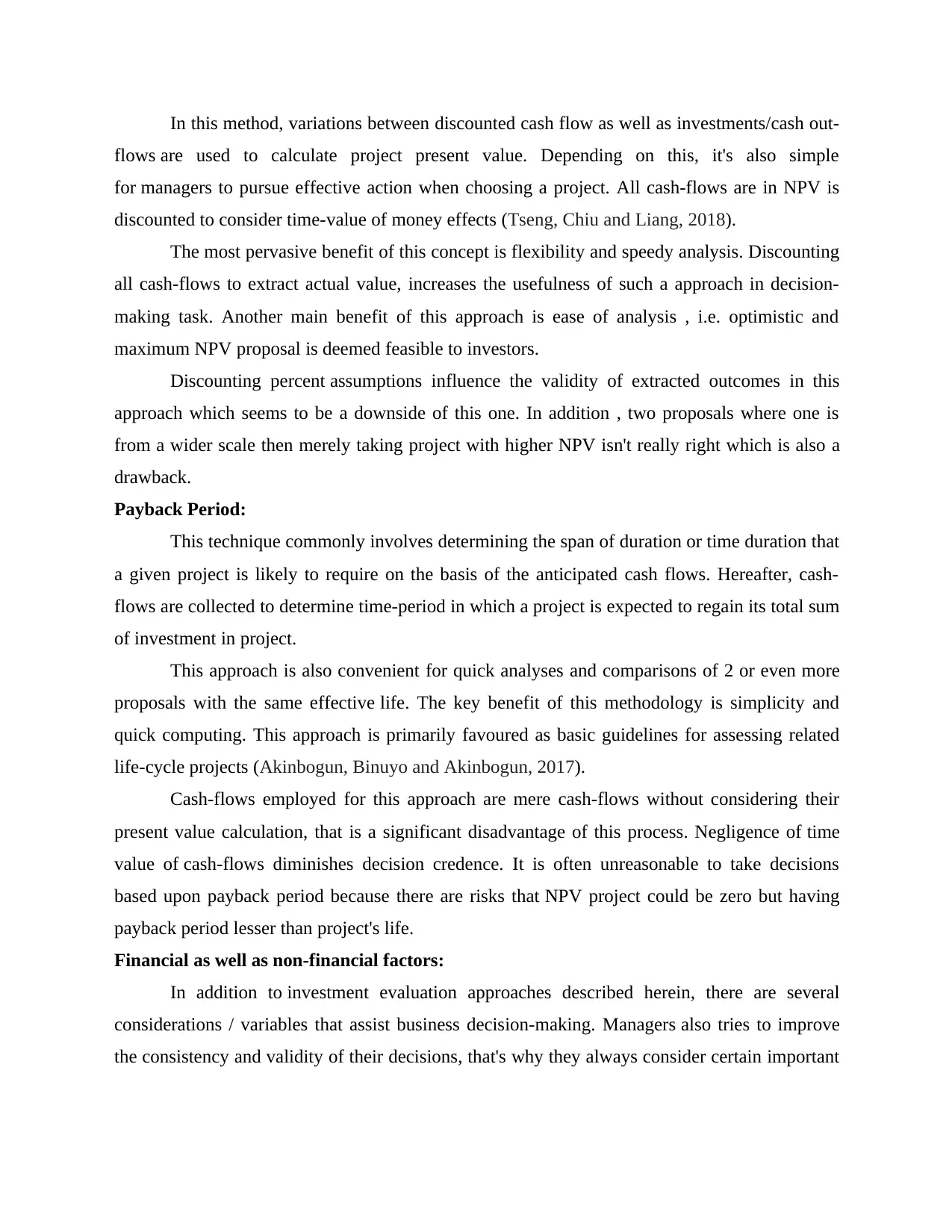
In this method, variations between discounted cash flow as well as investments/cash out-
flows are used to calculate project present value. Depending on this, it's also simple
for managers to pursue effective action when choosing a project. All cash-flows are in NPV is
discounted to consider time-value of money effects (Tseng, Chiu and Liang, 2018).
The most pervasive benefit of this concept is flexibility and speedy analysis. Discounting
all cash-flows to extract actual value, increases the usefulness of such a approach in decision-
making task. Another main benefit of this approach is ease of analysis , i.e. optimistic and
maximum NPV proposal is deemed feasible to investors.
Discounting percent assumptions influence the validity of extracted outcomes in this
approach which seems to be a downside of this one. In addition , two proposals where one is
from a wider scale then merely taking project with higher NPV isn't really right which is also a
drawback.
Payback Period:
This technique commonly involves determining the span of duration or time duration that
a given project is likely to require on the basis of the anticipated cash flows. Hereafter, cash-
flows are collected to determine time-period in which a project is expected to regain its total sum
of investment in project.
This approach is also convenient for quick analyses and comparisons of 2 or even more
proposals with the same effective life. The key benefit of this methodology is simplicity and
quick computing. This approach is primarily favoured as basic guidelines for assessing related
life-cycle projects (Akinbogun, Binuyo and Akinbogun, 2017).
Cash-flows employed for this approach are mere cash-flows without considering their
present value calculation, that is a significant disadvantage of this process. Negligence of time
value of cash-flows diminishes decision credence. It is often unreasonable to take decisions
based upon payback period because there are risks that NPV project could be zero but having
payback period lesser than project's life.
Financial as well as non-financial factors:
In addition to investment evaluation approaches described herein, there are several
considerations / variables that assist business decision-making. Managers also tries to improve
the consistency and validity of their decisions, that's why they always consider certain important
flows are used to calculate project present value. Depending on this, it's also simple
for managers to pursue effective action when choosing a project. All cash-flows are in NPV is
discounted to consider time-value of money effects (Tseng, Chiu and Liang, 2018).
The most pervasive benefit of this concept is flexibility and speedy analysis. Discounting
all cash-flows to extract actual value, increases the usefulness of such a approach in decision-
making task. Another main benefit of this approach is ease of analysis , i.e. optimistic and
maximum NPV proposal is deemed feasible to investors.
Discounting percent assumptions influence the validity of extracted outcomes in this
approach which seems to be a downside of this one. In addition , two proposals where one is
from a wider scale then merely taking project with higher NPV isn't really right which is also a
drawback.
Payback Period:
This technique commonly involves determining the span of duration or time duration that
a given project is likely to require on the basis of the anticipated cash flows. Hereafter, cash-
flows are collected to determine time-period in which a project is expected to regain its total sum
of investment in project.
This approach is also convenient for quick analyses and comparisons of 2 or even more
proposals with the same effective life. The key benefit of this methodology is simplicity and
quick computing. This approach is primarily favoured as basic guidelines for assessing related
life-cycle projects (Akinbogun, Binuyo and Akinbogun, 2017).
Cash-flows employed for this approach are mere cash-flows without considering their
present value calculation, that is a significant disadvantage of this process. Negligence of time
value of cash-flows diminishes decision credence. It is often unreasonable to take decisions
based upon payback period because there are risks that NPV project could be zero but having
payback period lesser than project's life.
Financial as well as non-financial factors:
In addition to investment evaluation approaches described herein, there are several
considerations / variables that assist business decision-making. Managers also tries to improve
the consistency and validity of their decisions, that's why they always consider certain important
⊘ This is a preview!⊘
Do you want full access?
Subscribe today to unlock all pages.

Trusted by 1+ million students worldwide
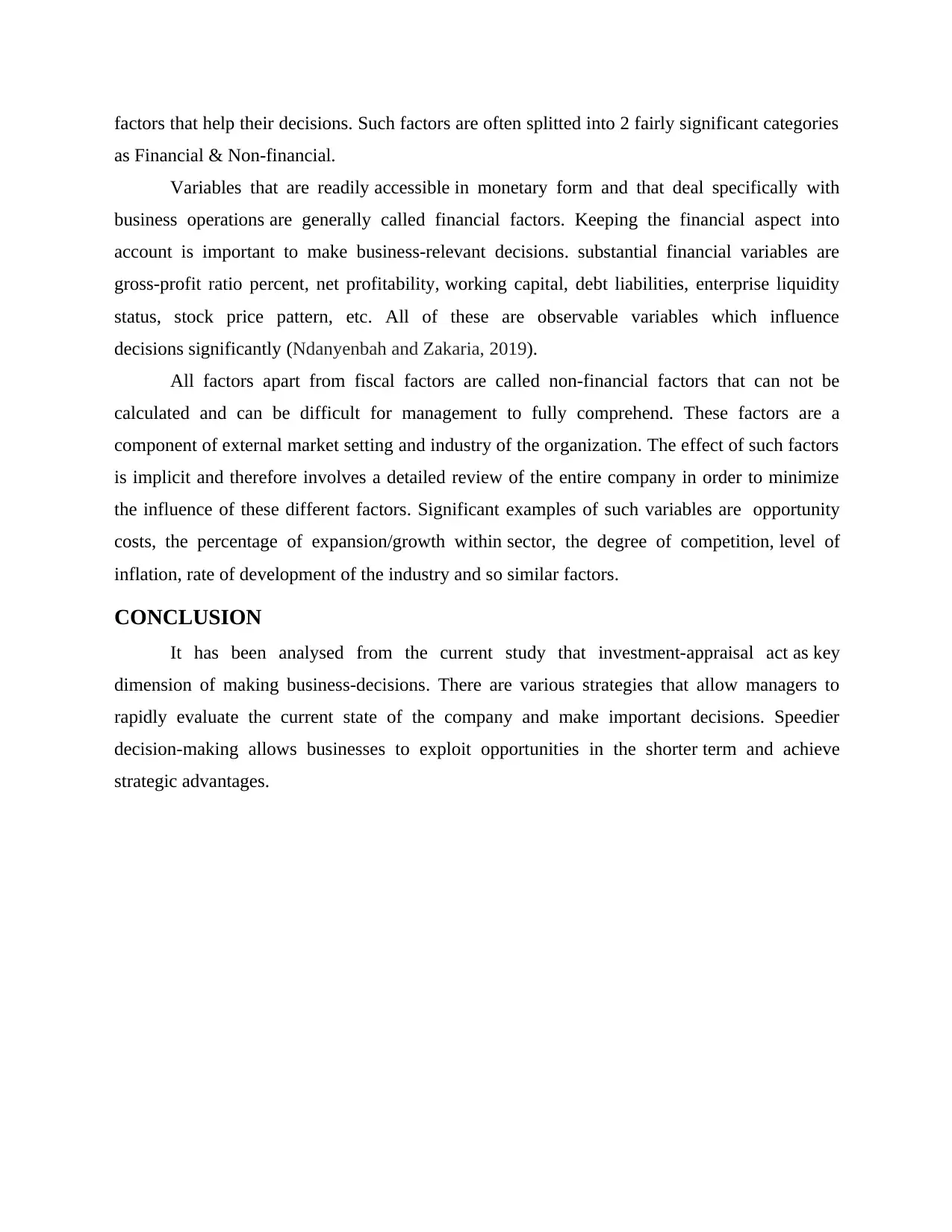
factors that help their decisions. Such factors are often splitted into 2 fairly significant categories
as Financial & Non-financial.
Variables that are readily accessible in monetary form and that deal specifically with
business operations are generally called financial factors. Keeping the financial aspect into
account is important to make business-relevant decisions. substantial financial variables are
gross-profit ratio percent, net profitability, working capital, debt liabilities, enterprise liquidity
status, stock price pattern, etc. All of these are observable variables which influence
decisions significantly (Ndanyenbah and Zakaria, 2019).
All factors apart from fiscal factors are called non-financial factors that can not be
calculated and can be difficult for management to fully comprehend. These factors are a
component of external market setting and industry of the organization. The effect of such factors
is implicit and therefore involves a detailed review of the entire company in order to minimize
the influence of these different factors. Significant examples of such variables are opportunity
costs, the percentage of expansion/growth within sector, the degree of competition, level of
inflation, rate of development of the industry and so similar factors.
CONCLUSION
It has been analysed from the current study that investment-appraisal act as key
dimension of making business-decisions. There are various strategies that allow managers to
rapidly evaluate the current state of the company and make important decisions. Speedier
decision-making allows businesses to exploit opportunities in the shorter term and achieve
strategic advantages.
as Financial & Non-financial.
Variables that are readily accessible in monetary form and that deal specifically with
business operations are generally called financial factors. Keeping the financial aspect into
account is important to make business-relevant decisions. substantial financial variables are
gross-profit ratio percent, net profitability, working capital, debt liabilities, enterprise liquidity
status, stock price pattern, etc. All of these are observable variables which influence
decisions significantly (Ndanyenbah and Zakaria, 2019).
All factors apart from fiscal factors are called non-financial factors that can not be
calculated and can be difficult for management to fully comprehend. These factors are a
component of external market setting and industry of the organization. The effect of such factors
is implicit and therefore involves a detailed review of the entire company in order to minimize
the influence of these different factors. Significant examples of such variables are opportunity
costs, the percentage of expansion/growth within sector, the degree of competition, level of
inflation, rate of development of the industry and so similar factors.
CONCLUSION
It has been analysed from the current study that investment-appraisal act as key
dimension of making business-decisions. There are various strategies that allow managers to
rapidly evaluate the current state of the company and make important decisions. Speedier
decision-making allows businesses to exploit opportunities in the shorter term and achieve
strategic advantages.
Paraphrase This Document
Need a fresh take? Get an instant paraphrase of this document with our AI Paraphraser
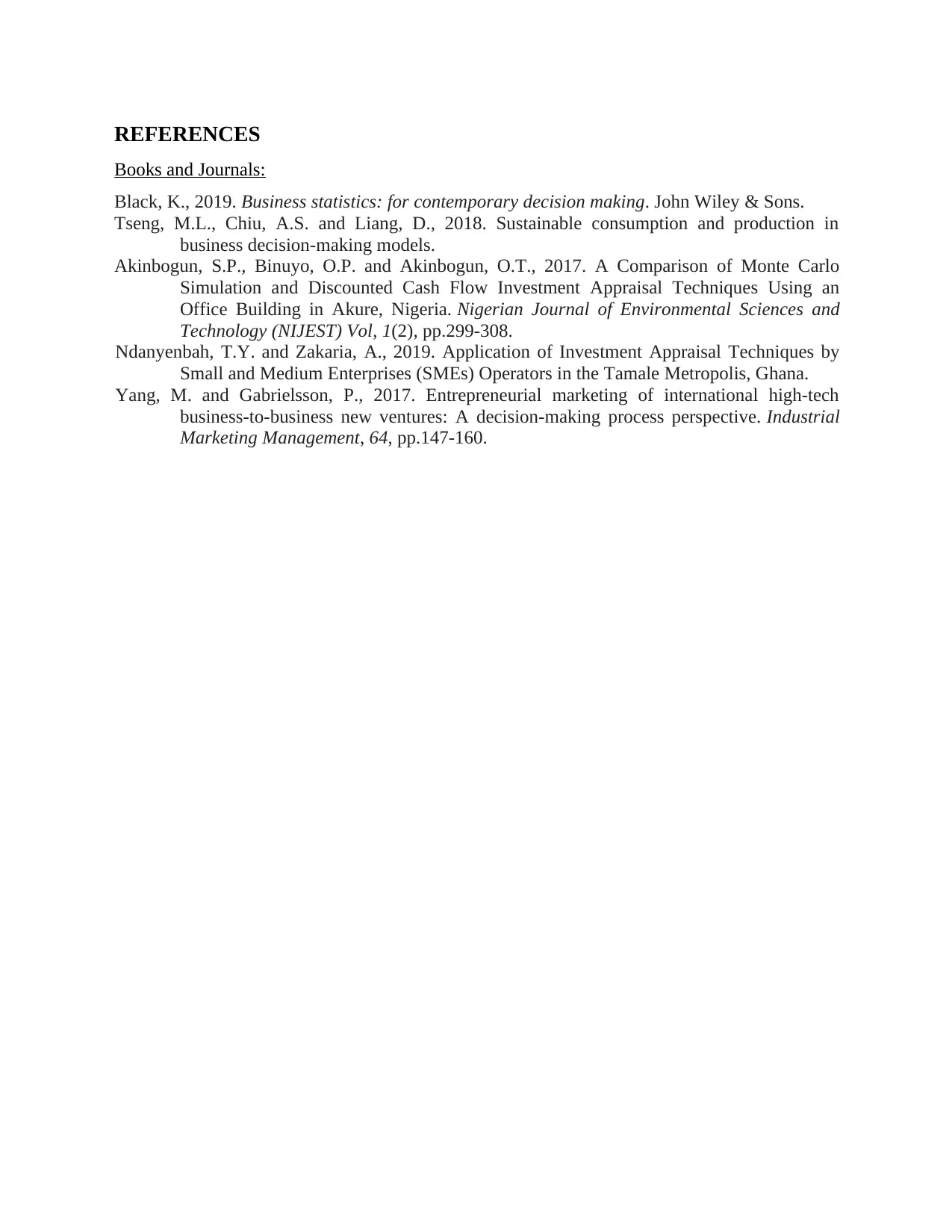
REFERENCES
Books and Journals:
Black, K., 2019. Business statistics: for contemporary decision making. John Wiley & Sons.
Tseng, M.L., Chiu, A.S. and Liang, D., 2018. Sustainable consumption and production in
business decision-making models.
Akinbogun, S.P., Binuyo, O.P. and Akinbogun, O.T., 2017. A Comparison of Monte Carlo
Simulation and Discounted Cash Flow Investment Appraisal Techniques Using an
Office Building in Akure, Nigeria. Nigerian Journal of Environmental Sciences and
Technology (NIJEST) Vol, 1(2), pp.299-308.
Ndanyenbah, T.Y. and Zakaria, A., 2019. Application of Investment Appraisal Techniques by
Small and Medium Enterprises (SMEs) Operators in the Tamale Metropolis, Ghana.
Yang, M. and Gabrielsson, P., 2017. Entrepreneurial marketing of international high-tech
business-to-business new ventures: A decision-making process perspective. Industrial
Marketing Management, 64, pp.147-160.
Books and Journals:
Black, K., 2019. Business statistics: for contemporary decision making. John Wiley & Sons.
Tseng, M.L., Chiu, A.S. and Liang, D., 2018. Sustainable consumption and production in
business decision-making models.
Akinbogun, S.P., Binuyo, O.P. and Akinbogun, O.T., 2017. A Comparison of Monte Carlo
Simulation and Discounted Cash Flow Investment Appraisal Techniques Using an
Office Building in Akure, Nigeria. Nigerian Journal of Environmental Sciences and
Technology (NIJEST) Vol, 1(2), pp.299-308.
Ndanyenbah, T.Y. and Zakaria, A., 2019. Application of Investment Appraisal Techniques by
Small and Medium Enterprises (SMEs) Operators in the Tamale Metropolis, Ghana.
Yang, M. and Gabrielsson, P., 2017. Entrepreneurial marketing of international high-tech
business-to-business new ventures: A decision-making process perspective. Industrial
Marketing Management, 64, pp.147-160.
1 out of 8
Related Documents
Your All-in-One AI-Powered Toolkit for Academic Success.
+13062052269
info@desklib.com
Available 24*7 on WhatsApp / Email
![[object Object]](/_next/static/media/star-bottom.7253800d.svg)
Unlock your academic potential
Copyright © 2020–2025 A2Z Services. All Rights Reserved. Developed and managed by ZUCOL.





